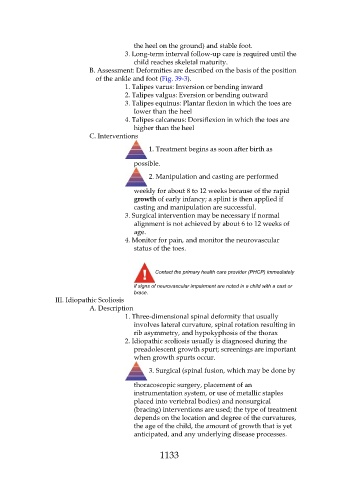Page 1133 - Saunders Comprehensive Review For NCLEX-RN
P. 1133
the heel on the ground) and stable foot.
3. Long-term interval follow-up care is required until the
child reaches skeletal maturity.
B. Assessment: Deformities are described on the basis of the position
of the ankle and foot (Fig. 39-3).
1. Talipes varus: Inversion or bending inward
2. Talipes valgus: Eversion or bending outward
3. Talipes equinus: Plantar flexion in which the toes are
lower than the heel
4. Talipes calcaneus: Dorsiflexion in which the toes are
higher than the heel
C. Interventions
1. Treatment begins as soon after birth as
possible.
2. Manipulation and casting are performed
weekly for about 8 to 12 weeks because of the rapid
growth of early infancy; a splint is then applied if
casting and manipulation are successful.
3. Surgical intervention may be necessary if normal
alignment is not achieved by about 6 to 12 weeks of
age.
4. Monitor for pain, and monitor the neurovascular
status of the toes.
Contact the primary health care provider (PHCP) immediately
if signs of neurovascular impairment are noted in a child with a cast or
brace.
III. Idiopathic Scoliosis
A. Description
1. Three-dimensional spinal deformity that usually
involves lateral curvature, spinal rotation resulting in
rib asymmetry, and hypokyphosis of the thorax
2. Idiopathic scoliosis usually is diagnosed during the
preadolescent growth spurt; screenings are important
when growth spurts occur.
3. Surgical (spinal fusion, which may be done by
thoracoscopic surgery, placement of an
instrumentation system, or use of metallic staples
placed into vertebral bodies) and nonsurgical
(bracing) interventions are used; the type of treatment
depends on the location and degree of the curvatures,
the age of the child, the amount of growth that is yet
anticipated, and any underlying disease processes.
1133

